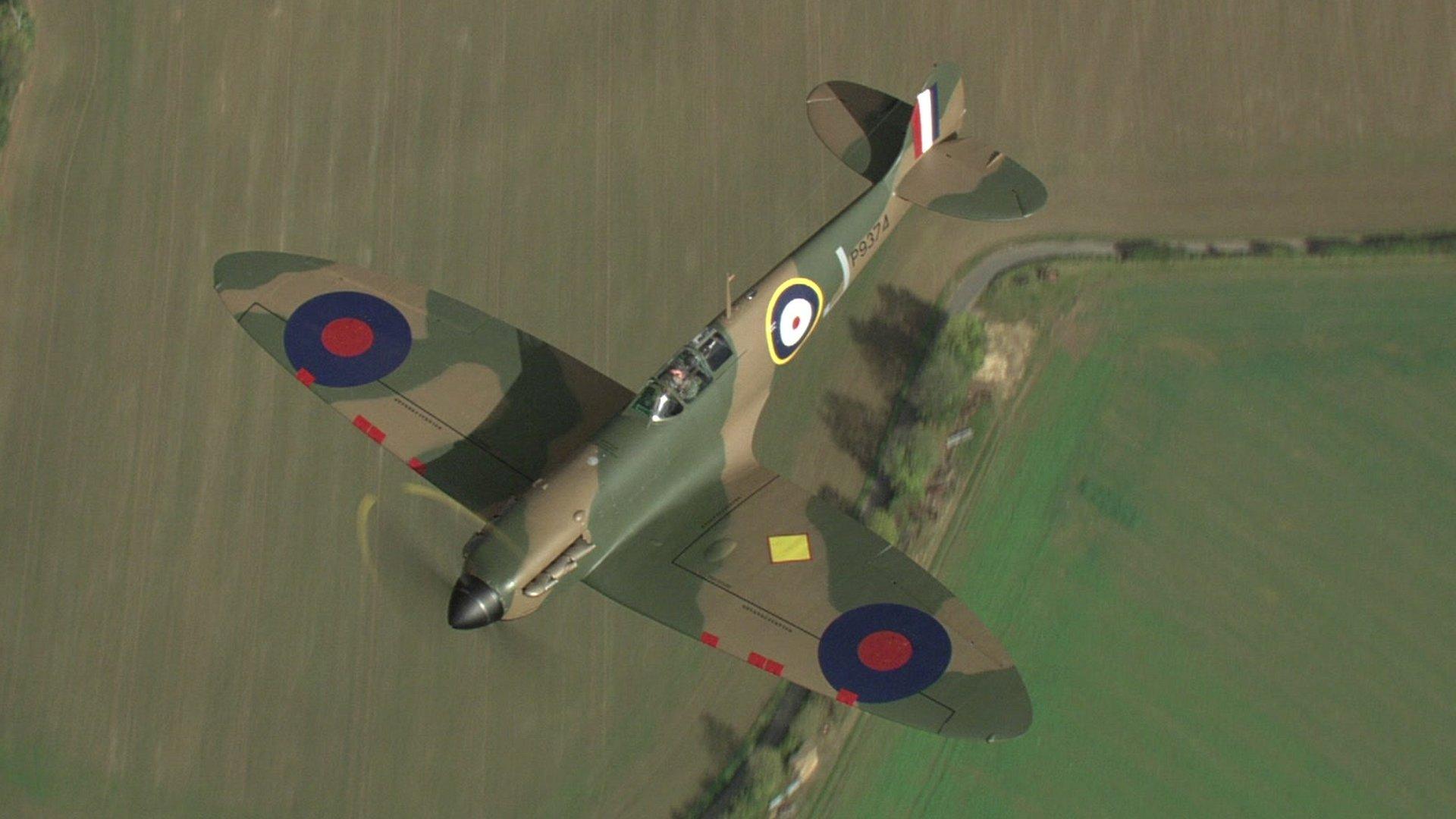What does it take to restore a World War Two Spitfire?
- Published
John Romain explains how his team restored the Mark I Spitfire
A rare example of one of the world's most iconic aircraft, a Mark 1 Spitfire that was painstakingly restored after being shot down during World War Two will be sold at Christie's.
While 22,500 Spitfires were originally built, just 56 are still airworthy, and most of these are later versions of the aircraft. There are only four Mark 1s still flying.
Christie's Nic McElhatton says interest in the aircraft has been incredible: "The plane we're selling is very special.", external
The aircraft is expected to fetch up to £2.5m ($3.9m) but could easily go for more. "We've had a number of clients who've expressed serious interest. Anything is possible," says Nic.
The sale on 9 July has thrown the spotlight on Britain's burgeoning vintage aviation restoration scene. Air displays are increasingly popular - the demand to see examples of rare and often unique aircraft seems never to have been higher.
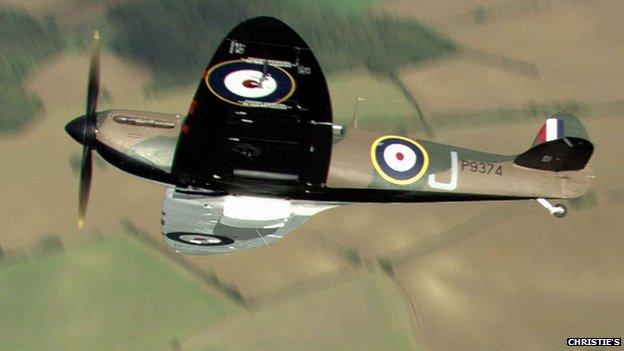
The black and white paint underside scheme was used to identify RAF planes from the ground but was abandoned in June 1940 and replaced with duck egg blue
There are now around 80 air shows a year in the UK from small locally-run events to big displays such as the Royal International Air Tattoo at Fairford and Flying Legends at Duxford, Cambridgeshire, which specialises in piston-engined aircraft, mainly from World War Two.
"People do make really significant journeys from all over the world," says Jane Larcombe of The Fighter Collection, that runs Flying Legends, external.
"There is a very big industry in the UK, building World War One and World War Two aircraft," says aviation historian Andy Saunders.
"Hidden away all round the country there are craftsmen, beavering away building remarkable aeroplanes."
Back in May 1940, Spitfire P9374 was being flown by Flying Officer Peter Cazenove, external when he was shot-down. Successfully crash-landing on Calais beach he radioed: "Tell mother I'll be home for tea."
Sadly getting back home for tea took longer than he hoped. He was captured and spent the rest of the war as a prisoner. His Spitfire sank into the sands and was forgotten about.
'This thin red line'
Then in 1980, winds and tides uncovered it again. Andy Saunders remembers getting an unexpected call from the manager of Calais hover port.
"He telephoned me out of the blue and I thought it was complete rubbish. But then he sent me the photos to prove it - it was pretty much intact when it emerged from the sand."
After languishing in storage, it was eventually bought by US billionaire and philanthropist Thomas Kaplan.
"I have always been a student of military history, it was a great passion from an early age - and in particular aviation history and the Battle of Britain," he says.
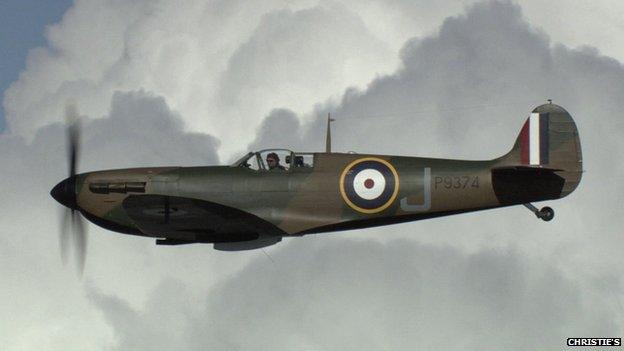
Despite 40 years on a beach, parts of the original engine were re-used, combined with another Merlin III engine
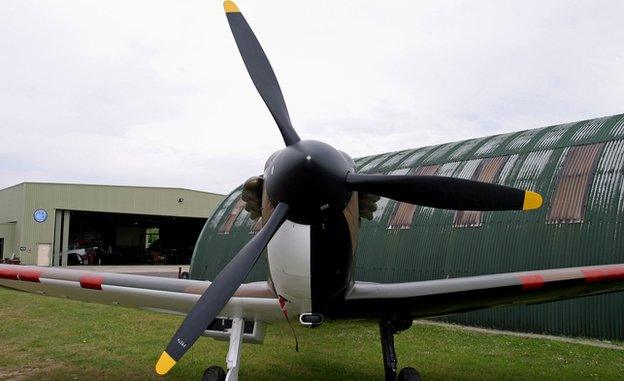
Mark 1 Spitfires used a three-blade metal de Havilland or Rotol propeller. None could be found, so a set of eight were made at a cost of "several hundred thousand pounds"
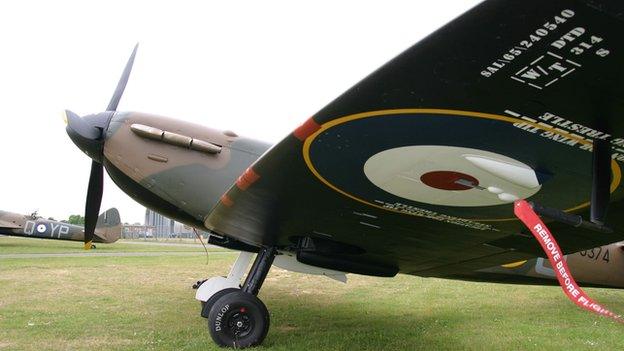
New tyres had to be made as well. This aircraft has smooth Dunlop tyres not used on later Spitfires
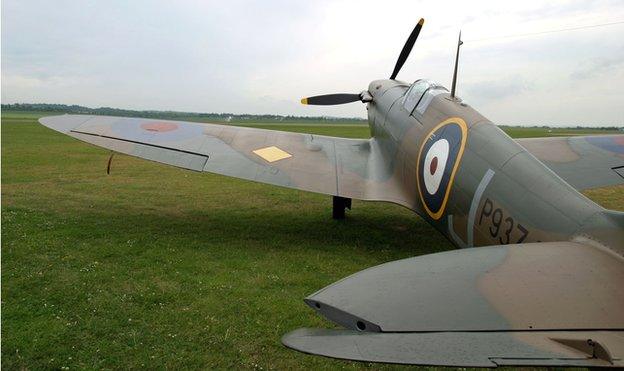
The yellow diamond of reactive paint on the wing was supposed to give early warning of a gas attack by turning black
When he found the wrecks of two Mark 1 Spitfires, he decided to restore them both to flight - and to exactly as they had been when they crashed - with no compromises.
One was Peter Cazenove's Spitfire that is now being auctioned for the RAF Benevolent Fund and the big cat charity, Panthera.
The other was flown by Geoffrey Stephenson, the commanding officer of 19 Squadron - based at Duxford - the first unit to be equipped with Spitfires.
Mr Kaplan is giving this second plane to the aviation branch of the Imperial War Museum, which is now based at the same airfield.
"For me it is a thank you to the UK - this thin red line separating us from barbarism - at a time when the United States was not in the war."

Battle of Britain: Myths and reality
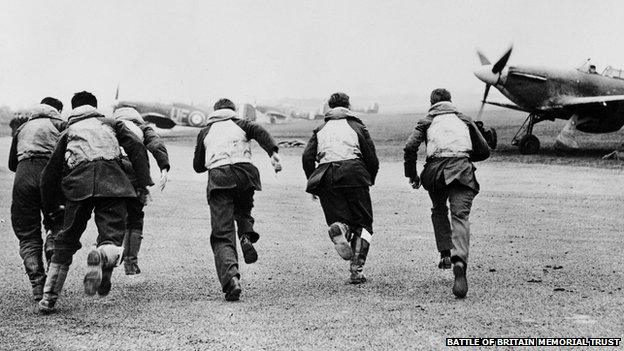
Pilots scramble for their Hurricanes. The less-glamorous Hurricane equipped two-thirds of squadrons and shot down more German planes than the Spitfire during 1940.
In 1940 it seemed that after the British army's evacuation from Dunkirk, and the fall of France, all that stood in the way of a German invasion was the RAF.
The Spitfire, designed by RJ Mitchell of Supermarine even as he was dying of cancer, came into frontline service just in time.
Intense air battles raged as the German air force, the Luftwaffe, tried to defeat the RAF as precursor to a possible landing.
Eventually the Luftwaffe gave up and Hitler turned his attention towards Russia. So how close did Britain come to defeat?
In popular myth, the RAF airfields were only spared because the Germans suddenly stopped bombing them and started attacking London instead.
Yet historian Stephen Bungay, author of The Most Dangerous Enemy, says in reality the Germans never came close to victory. The Luftwaffe was not trained for the low-level, hit-and-run attacks which might have worn down Britain's defences.
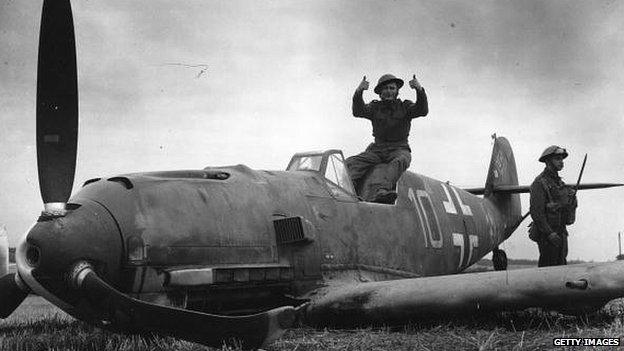
Battle of Britain casualties: The RAF had 537 airmen killed and lost 1,012 aircraft. The Luftwaffe had 2,662 airmen killed and lost 1,918 aircraft
"We were out-producing Germany in fighters by more than two-to-one, and we had a repair organisation that was turning around damaged fighters faster than they were."
RAF Fighter Command's strength actually grew during the battle, and even had it been defeated, the German invasion fleet would have had to get past the Royal Navy.
The true significance of the battle, says Stephen Bungay, is that it ensured Britain stayed in the war and helped shape the peace.
"If we'd gone out in 1940, the war would have been fought between Nazi Germany and the Soviet Union - and the Red Army would have likely won.
"Europe would have become part of a Soviet-dominated East, with Britain a marginalised satellite state and the US having far less influence and power in the world than it did."

Lengthy restoration
Both of Thomas Kaplan's Spitfires ended up at one of Europe's biggest aviation restoration specialists, The Aircraft Restoration Company (ARC) at Duxford.
The hardest challenge was working out exactly what a Mark 1 Spitfire looked like, as records weren't often kept, says ARC engineer Martin Overall.
"They changed so rapidly and you'd find aircraft three or four months older that were completely different, because they'd been modified just to keep pace with German development.

During the war Spitfires were mass-produced but in restoration projects like this they are now hand-built
"We investigated several crash sites and gained a snapshot of what the aircraft would have been like."
It took 12 engineers three years to restore it at a cost of several millions, though exactly how much nobody will say - but eventually Spitfire P9374 flew again.
"It was just a breath-taking moment," says Andy Saunders.
"Having seen the wreck when it came off the beach, I never dreamed it would be recreated and fly."
Besides restoring Spitfires, ARC regularly works on up to eight major restoration projects for clients. Manager John Romain says companies like his are helping preserve vital engineering skills.
"There's a lot of old skill-sets in our industry, from sheet metalworkers to the electricians. There's a lot of interest in working with us now, so we have our own apprenticeship scheme which gives us our engineers of the future."
Restoration to re-manufacturing
ARC is not the only company in the business. In Sussex a team of engineers at Retrotec specialise in restoring biplanes.
Over the past 28 years, the firm has restored a string of rare World War One and 1930s era aircraft.
"We started off maintaining old aircraft, moved to restoration and repair, and now we are basically re-manufacturing aircraft," says owner Guy Black.
"The silver biplanes of the Thirties are a very romantic and important stage of aircraft development.
"They are also extremely beautiful aircraft, representing an era that will probably never happen again."
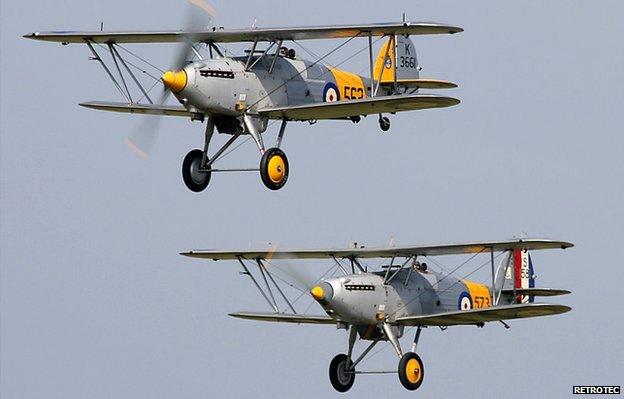
Two Hawker Nimrods, both restored by Retrotec. This was a naval fighter designed to operate from aircraft carriers
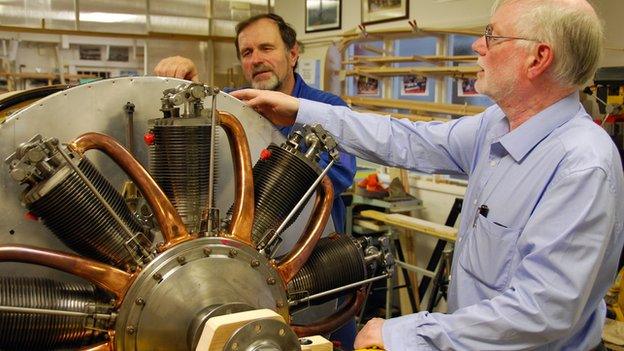
Guy Black (pictured right) checks out a Le Rhone engine on a Sopwith Pup fuselage

Found in an elephant stable in India, the hope is that this World War One DH9 bomber will fly again this year
The company is now in effect an aircraft manufacturer in miniature: in its workshops its engineers carry out design work, metal work, airframe manufacturing, engine rebuilds, as well as woodwork and fabric covering.
Currently Guy's team is working on a World War One DH9 bomber, one of a pair were in an elephant stables in India and brought back to the UK for restoration.
Nobody's ever restored such a plane to flight before, and Retrotec hopes to have it flying this year.
But when it comes to the aircraft engineers of the future, he says the lack of training in schools is a concern.
"There is very little training in practical engineering or practical woodwork," says Mr Black. "There seems to be a drive to ensure everyone has a degree in engineering, but there's very few people interested in doing hands-on work."
Spitfire handover
Back at Duxford, Thomas Kaplan plans to officially hand over Geoffrey Stephenson's Spitfire to the Imperial War Museum on 9 July, and then head down to London to watch Peter Cazenove's aircraft being auctioned off.
"To me it is all about 'The Few' who stood up and said - this is the line beyond which we won't be pushed."
Rightly or wrongly the Spitfire, thank perhaps to those elliptical wings, easily outshines many other aircraft in people's affections.
Says Christie's Nic McElhatton: "You look at the silhouette of a Spitfire and you recognize it instantly.
"It's timeless, it is the most perfect piece of engineering - a work of art."
- Published9 July 2015
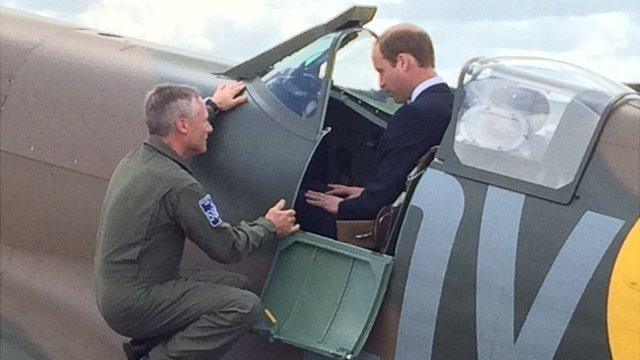
- Published4 July 2015

- Published4 July 2015
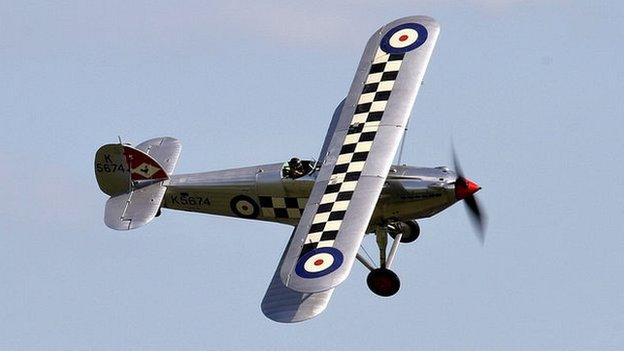
- Published3 July 2015
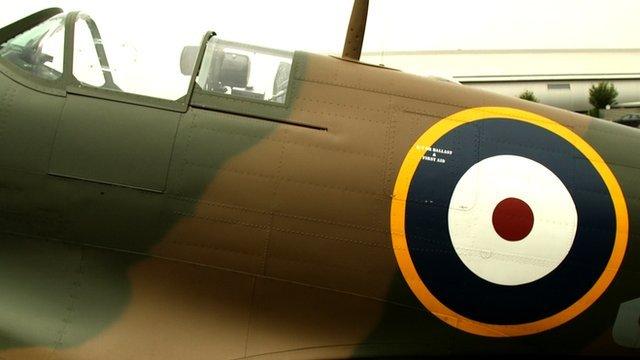
- Published3 July 2015
